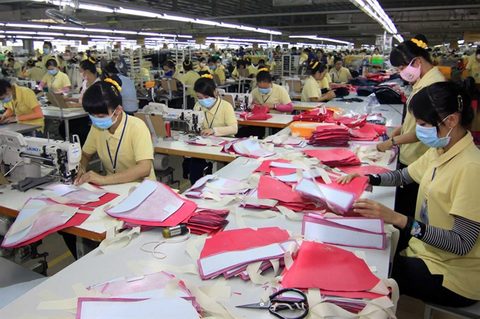Vietnam leatherware makers make a mark
 |
| Workers manufacture women handbags at the Simone Accessories Collection Viet Nam TG Ltd’s factory in Tan Huong Industrial Zone, Tien Giang Province - VNA Photo Vu Sinh |
The Vietnam Leather, Footwear and Handbag Association (LEFASO) announced recently that Viet Nam was the fifth largest exporter of handbags and suitcases in the world, accounting for 5.4 per cent of global supply.
The country produces over US$3.2 billion worth of handbags, suitcases and backpacks that are exported to 10 major markets. A large number of factories have become trusted producers for major multinational brands.
Nguyen Duc Thuan, LEFASO’s Chairman, said the nation’s leather industry has grown by 10 to 15 per cent per year for the past five years, driven significantly by international fashion brands moving their handbag manufacturing facilities to Viet Nam.
Thuan said a majority of fashion houses have chosen to replace Chinese manufacturers with Vietnamese ones through foreign direct investment.
In the first five months of 2017, the US was the largest market for Vietnamese suitcases, backpacks, and handbags worth $555 million, a six per cent increase over the same period in 2016, according to the General Department of Customs.
The EU was second, importing goods worth $365 million, up 8.2 per cent year on year.
Exports to other main markets included Japan at $146.5 million, up 1.7 per cent; China at $57.6 million, down 6.8 per cent; and South Korea at $52.8 million, down 0.4 per cent.
Nguyen Minh Phong, Head of the Economic Research Section of the Ha Noi Socio-Economic Development Research Institute, had said in June that bag producers in Viet Nam should diversify their export markets, with emphasis on the US and EU markets.
Phong also said that the founding of the ASEAN Economic Community (AEC) in 2015 would pose new challenges for Vietnamese leatherware industry. However, he believed the country could turn this into an advantage and expand exports to other ASEAN markets instead.
He recommended that Vietnamese bag makers work together with their counterparts in Thailand, Malaysia or Indonesia to create better value chains, cut costs and increase productivity, as materials are more accessible within the AEC than outside.
As local bag and suitcase manufacturers mainly perform outsourced tasks for FDI companies, they need to increase investment, expand production scale and improve product quality to gain a foothold in the domestic market.
At present, China still reigns as the world’s largest producer and exporter of backpacks, suitcases and handbags, churning out more than 40 per cent of total global output every year.
What the stars mean:
★ Poor ★ ★ Promising ★★★ Good ★★★★ Very good ★★★★★ Exceptional
Latest News
More News
- Businesses ramp up production as year-end orders surge (December 30, 2025 | 10:05)
- Vietjet chairwoman awarded Labour Hero title (December 29, 2025 | 13:06)
- How to unlock ESG value through green innovation (December 29, 2025 | 10:03)
- AI reshapes media and advertising industry (December 29, 2025 | 08:33)
- FPT and GELEX sign deal to develop blockchain tech for global markets (December 29, 2025 | 08:29)
- Vietnam’s GDP forecast to grow by 9 per cent in 2026 (December 29, 2025 | 08:29)
- Women entrepreneurs are key to Vietnam’s economic growth (December 29, 2025 | 08:00)
- Vietnam's top 500 value-creating enterprises announced (December 27, 2025 | 08:00)
- The PAN Group shaping a better future with ESG strategy (December 26, 2025 | 09:00)
- Masan Consumer officially lists on HSX, marking the next phase of value creation (December 25, 2025 | 13:20)

















 Mobile Version
Mobile Version